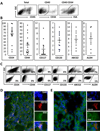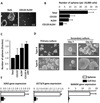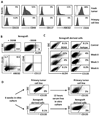Expression of aldehyde dehydrogenase and CD133 defines ovarian cancer stem cells
- PMID: 21480217
- PMCID: PMC3164893
- DOI: 10.1002/ijc.25967
Expression of aldehyde dehydrogenase and CD133 defines ovarian cancer stem cells
Abstract
Identification of cancer stem cells is crucial for advancing cancer biology and therapy. Several markers including CD24, CD44, CD117, CD133, the G subfamily of ATP-binding cassette transporters (ABCG), epithelial specific antigen (ESA) and aldehyde dehydrogenase (ALDH) are used to identify and investigate human epithelial cancer stem cells in the literature. We have now systemically analyzed and compared the expression of these markers in fresh ovarian epithelial carcinomas. Although the expression levels of these markers were unexpectedly variable and partially overlapping in fresh ovarian cancer cells from different donors, we reliably detected important levels of CD133 and ALDH in the majority of fresh ovarian cancer. Furthermore, most of these stem cell markers including CD133 and ALDH were gradually lost following in vitro passage of primary tumor cells. However, the expression of ALDH and CD133, but not CD24, CD44 and CD117, could be partially rescued by the in vitro serum-free and sphere cultures and by the in vivo passage in the immune-deficient xenografts. ALDH+ and CD133+ cells formed three-dimensional spheres more efficiently than their negative counterparts. These sphere-forming cells expressed high levels of stem cell core gene transcripts and could be expanded and form additional spheres in long-term culture. ALDH+ , CD133+ and ALDH+ CD133+ cells from fresh tumors developed larger tumors more rapidly than their negative counterparts. This property was preserved in the xenografted tumors. Altogether, the data suggest that ALDH+ and CD133+ cells are enriched with ovarian cancer-initiating (stem) cells and that ALDH and CD133 may be widely used as reliable markers to investigate ovarian cancer stem cell biology.
Copyright © 2011 UICC.
Conflict of interest statement
We have no financial conflict of interest.
Figures





References
-
- Zou W. Immunosuppressive networks in the tumour environment and their therapeutic relevance. Nat Rev Cancer. 2005;5:263–274. - PubMed
-
- Zou W. Regulatory T cells, tumour immunity and immunotherapy. Nat Rev Immunol. 2006;6:295–307. - PubMed
-
- Zou W, Chen L. Inhibitory B7-family molecules in the tumour microenvironment. Nat Rev Immunol. 2008;8:467–477. - PubMed
-
- Reya T, Morrison SJ, Clarke MF, Weissman IL. Stem cells, cancer, and cancer stem cells. Nature. 2001;414:105–111. - PubMed
Publication types
MeSH terms
Substances
Grants and funding
LinkOut - more resources
Full Text Sources
Other Literature Sources
Medical
Research Materials
Miscellaneous

